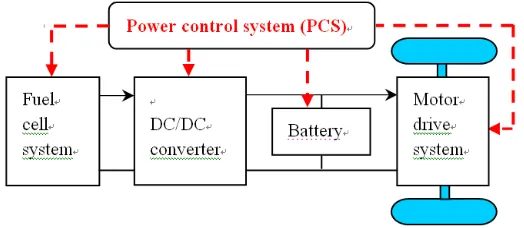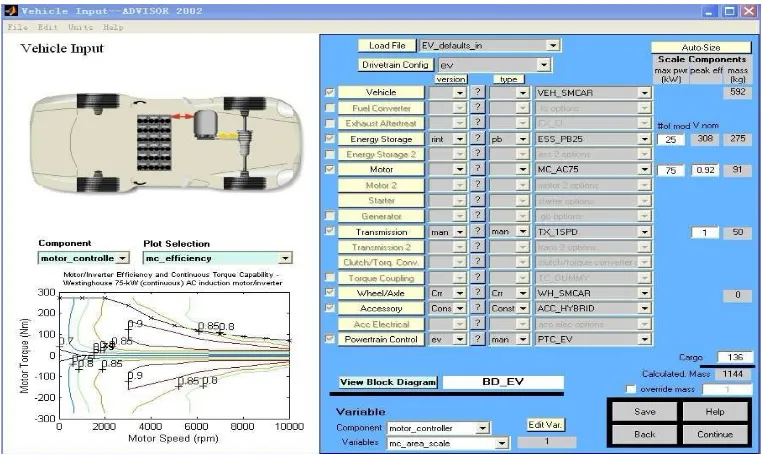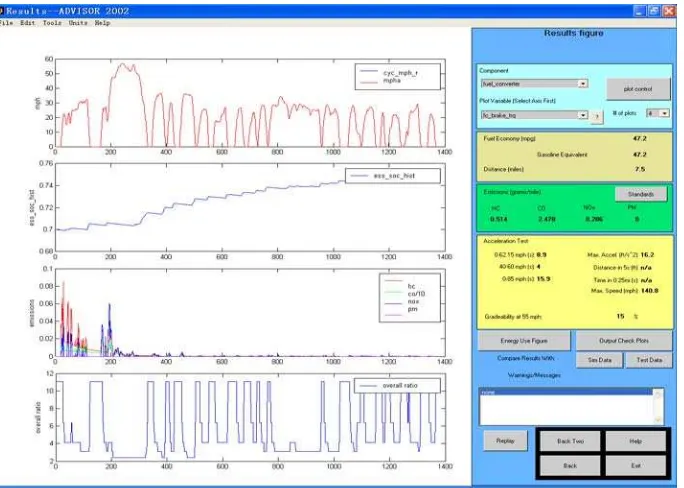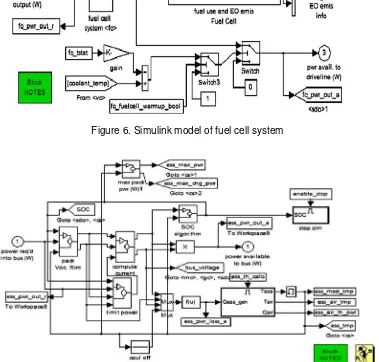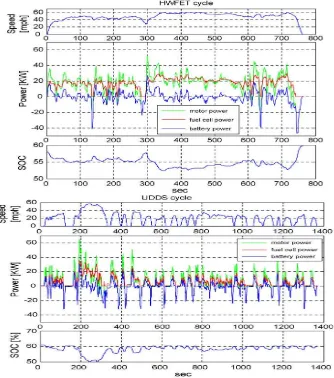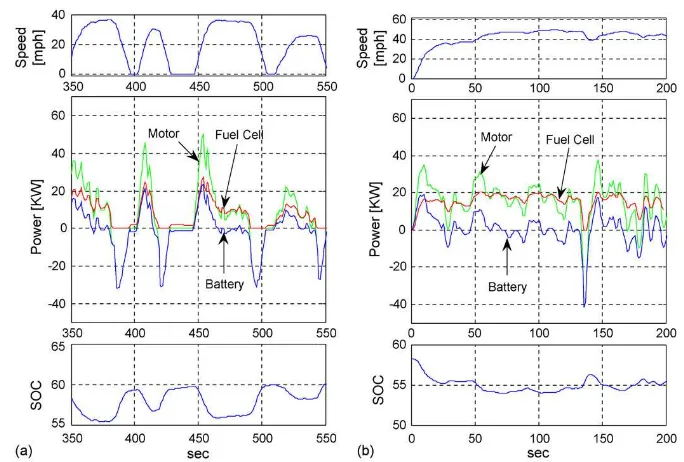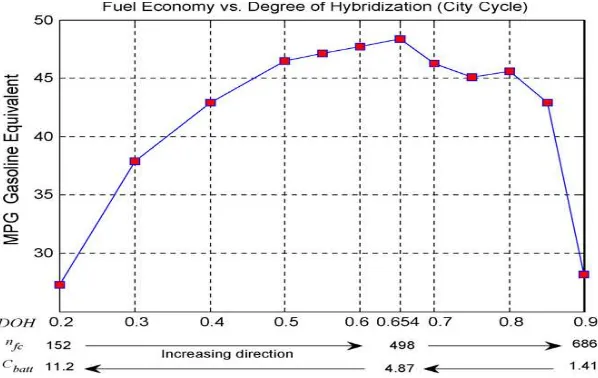Abstract
In order to enhance the fuel economy of hybrid vehicle and increase the mileage of continuation of journey, the power control strategy (PCS) is as significant as component sizing in achieving optimal fuel economy of the fuel cell/battery hybrid vehicle (FCBHV). The models of FCBHV structure and optimal power control strategy are developed by electric vehicle simulation software ADVISOR which uses a hybrid backward/forward approach. The results demonstrate that the proposed control strategy can satisfy the power requirement for two standard driving cycles and achieve the power distribution among various power sources. The comprehensive comparisons with the power tracking controller (PTC) which is wide adopted in ADVISOR verify that the proposed control strategy has better rationality and validity in terms of fuel economy and dynamic property in two standard driving cycles. Therefore, the proposed strategy will provide a novel approach for the advanced power control system of FCBHV.
Keywords: FCBHV, Power Control Strategy, ADVISOR, Driving Cycles
1. Introduction
Hybrid vehicles are vehicles that use two or more power sources for the drive system. In contrast, ordinary internal combustion engine (ICE) vehicles use a single power source consisting of reciprocating engine, typically fueled with gasoline, to drive a complex transmission mechanism that is then coupled to the drive wheels [1],[2]. The disadvantages of ICE vehicles include low energy efficiency, excessive harmful chemical emissions, high noise level and heavy dependence on a single fuel source. Hybrid electric vehicles are one of the solutions proposed to tackle the perceived problems associated with the energy crisis and global warming [3]. Hybrid vehicles seamlessly combine two or more power sources into one drive system. The fuel cell/battery hybrid vehicle (FCBHV) merges hybrid vehicle and the hydrogen fuel cell technologies in order to replace the conventional fuel and optimize the fuel consumption.
Power control strategy (PCS) and component sizing affect vehicle performance and fuel economy considerably in FCBHV because of the multiple power sources and differences in their characteristics. Furthermore, these two important factors are coupled—different selection of component sizing should come with different design of power control strategy. Therefore, to achieve maximum fuel economy for FCBHV, optimal power control and component sizing should be determined as a combined package. Our research has formulated and solved a power control problem of a FCBHV. Development of the power control strategy is one of the important tasks in developing hybrid vehicles and relatively many literatures can be found. Y. Guezennec et al. [4] solved the supervisory control problem of a FCBHV as a quasi-static optimization problem and found that hybridization can significantly improve the fuel economy of FCBHV. Wang Y et al. [5] used the equivalent consumption minimization strategy to determine an optimal power distribution for a fuel cell/supercapacitor hybrid vehicle. The concept of equivalent factors in hybrid electric vehicles has been described by Xiaolan Wu et al. [6]. In the same research, they also compared their power control result to deterministic dynamic programming result, which can lead to a global optimality.
distributed power generation, and portable power source [7]-[9]. Due to slow dynamic characteristic of fuel cell, a FCBHV has been proposed. The power control of hybrid vehicle which determines the power assignment between the fuel cell system and auxiliary energy storage devices is an important technique.
In recent years, a variety of control strategies for power control have been used to hybrid vehicle. Thounthong et al. [10] had used an innovative control law based on flatness properties for fuel cell/supercapacitor hybrid power source. Paladini et al. [11] had presented an optimal control strategy to power a vehicle with both fuel cell and battery to reduce fuel consumption. However, in these works the proposed control strategies had not adequately considered the balance between fuel economy and dynamic property of hybrid vehicle [12]. Furthermore, an appropriate intelligent control strategy had not been proposed for a hybrid vehicle. In this paper, a secondary development for electric vehicle simulation software ADVISOR is implemented based on the system architecture of FCBHV.
In order to enhance the fuel economy of hybrid vehicle and increase the mileage of continuation of journey, the PCS is as significant as component sizing in achieving optimal fuel economy of the FCBHV. Control strategies were largely based on heuristic rules, which is usually far from true-optimality. This study presents a combined power control of FCBHV, the power control algorithm was developed from stochastic dynamic programming (SDP) motivated basis functions. According to standard driving cycle conditions, the proposed control strategy is contrasted with the power tracking control strategy which is wide adopted in ADVISOR in terms of the indexes of fuel economy and dynamic property.
2. FCBHV Structure and Optimal Power Control Strategy
With the advancement in the technology of fuel cells, there is an increasing interest in using fuel cells for hybrid vehicle [13]. The FCBHV is a popular hybrid structure as Figure 1 shown. In this structure, a fuel cell system designed for vehicular propulsion application must have a power density, a startup, and a transient response similar to present-day ICE-based vehicles. A battery is generally connected across the fuel cell system to provide supplemental power for starting the system. The fuel cell system and inverter connect by a unidirectional DC/DC converter for matching voltage class. The advantages of this structure are low power and transient response demand from the fuel cell system and convenient braking energy recovery.
Figure 1 shows the FCBHV structure and key control signals for power control. FCBHV consists of several subsystems: driver, fuel cell system (FCS), battery, DC/DC converter, electric drive, and vehicle dynamics. Considering various vehicle states – such as power demand, battery state of charge (SOC), and vehicle speed – the power control system (PCS) sends the fuel cell current request to the DC/DC converter; sends the motor torque request to the electric drive; controls the regenerative braking ratio. In order to generate the motor torque requested from the PCS, the inverter draws current from the electric DC bus where the battery and the DC/DC converter are connected in parallel. The DC/DC converter can control the current flow into the DC bus, whereas the battery here is “passively” connected to the DC bus– the difference between the current draw from the inverter and the current outflow from the DC/DC converter will be compensated by the passive battery. Therefore, the power split ratio between the battery and the fuel cell system is achieved by the PCS sending the fuel cell net current request to the DC/DC converter.
The goal of power control in FBHV is to minimize fuel consumption while maintaining the battery SOC by sending adequate current request command to the DC/DC converter. To achieve this goal, optimal power control strategy needs to be designed for the PCS to balance the FCS power and the battery power. Many power control algorithms in technical literatures were designed by rule-based or heuristic methods. Those rule-based methods are simple and easy to understand because they come from engineering intuition. However, they often lack optimality or cycle-beating. Ideally, minimization of fuel consumption of hybrid vehicles can be achieved only when the driving scenario is known a priori. The deterministic dynamic programming technique can accomplish this global optimum. Then again, the result cannot be realized as a power control scheme because it is not possible to predict the future driving scenario.
Figure 1. Drive structure of FCBHV
The power control strategy designed by the SDP approach can overcome these limitations of existing algorithms [14]. The idea of the infinite horizon SDP is that if the overall power demand is modeled as a stochastic process, an optimal controller can be designed based on the stochastic model. First, the driver power demand is modeled as a discrete-time stochastic dynamic process by using a Markov chain model, which is constructed from standard driving cycles. In other words, the power demand from the drive at the next time step depends on the current power demand and vehicle speed:
l
respectively. Then, for the discretized state vector,
x
(SOC,wh,dem
P ), corresponding optimal
fuel cell current request command, uIfc,net,reg, is determined to minimize the expected cost of
hydrogen consumption and battery energy usage over infinite horizon:
penalizes the battery energy use based on the SOC value. This SDP problem can be either solved by a policy iteration or value iteration process. The resulting SDP control strategy generates optimal fuel cell current request as a function of battery SOC, wheel speed, and power demand. The control strategy achieves high fuel economy while successfully maintaining battery SOC.
3. ADVISOR MODEL OF FCBHV
4), where fuel economy and emissions are displayed alongside detailed plots of time-dependent outputs. The user can select from awide array of output options related to speed and torque, fuel consumption, emissions, battery charge level, etc., and display up to four plots simultaneously.
Figure 2. ADVISOR vehicle input screen
Figure 4. ADVISOR Results screen
Figure 5. Block diagram of the FCBHV configuration
50 kW power-efficiency model of International Fuel Cell Company is adopted as Figure 6 shown. A resistance–capacitance (RC) equivalent circuit model is used to develop the battery model as Figure 7 shown. The validity of these models was verified by plentiful experiments [19]-[22].
Figure 6. Simulink model of fuel cell system
Figure 7. Simulink model of batter
4. DRIVING CYCLES AND RESULTS
Figure 8. Comparisons between highway (above)/city (below) cycle
Figure 9. Comparison of optimal results for 200 s of (a) city cycle (b) highway cycle
Figure 10. Optimized PCS and vehicle state trajectories (a) city cycle (b) highway cycle
In Figure 9, results for city and highway cycles are compared. The city cycle of Figure 9(a) has more accelerations/decelerations so the vehicle can capture more regenerative braking energy. Therefore, the optimized sensitivity slope of the city cycle is relatively flat compared to that of the highway cycle, i.e.,
x
,city
x
,highway(Figure 10). Figure 9(b) shows the results forFigure 11. Optimized (a) fuel cell and (b) battery characteristics for city cycle
Figure 12. Effect of DOH on fuel economy for city cycle
The optimization process downsizes the compressor and increases the degree of hybridization (DOH), the DOH is the ratio of the combustion engine power to the total powertrain power. Thus, the FCS efficiency increases in the lower net power range from 0 to 26 kW, where the optimized fuel cell (FC) engine primarily operates (Figure 11). The maximum efficiency of the optimized FC engine is around 56%. Although the downsized compressor here reduces the maximum net power of the FCS, the optimized pseudo-SDP controller successfully runs the FCS within the reduced maximum net power limit. Figure 11(b) shows that even though the increased DOH reduces the battery size, the optimized battery design can still capture the majority of regenerative braking energy within its reduced power limit. If fuel cell vehicles go into production in the near future, their degree of hybridization will significantly impact the vehicle price due to high manufacturing and material costs of fuel cells and batteries [26]-[29]. Therefore, by examining the effect of DOH on fuel economy, car manufacturers can determine the trade-off between fuel savings and manufacturing costs.
5. Conclusion
In this paper, the PCS method which is implemented in ADVISOR environment is utilized to design relevant energy control strategies for FCBHV for the improvement of fuel economy and mileage of continuation of journey. A secondary development for ADVISOR is implemented based on the system architecture of FCBHV. We suggested a comprehensive and systematic framework that makes it possible to optimize power control and component sizing simultaneously for the design of FCBHV. The results indicate that the proposed control strategy can satisfy the power requirement for two standard driving cycles. In two cycle conditions, the PCS for FCBHV has smaller consumption than the PTC for FCBHV. Hence, the proposed strategy will give a novel approach for the advanced energy control system of FCBHV.
References
[1] Dingyue C, Lifeng W, Lihao C, Yu S, Jianchao B. The Design Method of Extended Range Electric Vehicles. Advanced Materials Research, 2014; 827: 61-65.
[2] Ramos PCA, Romero A, Giral R, Calvente J, Martinez-Salamero L. Mathematical analysis of hybrid topologies efficiency for PEM fuel cell power systems design. J Electr Power Energy Syst. 2010; 32(5): 1049-1061.
[3] Hajizadeh A, Golkar MA. Control of hybrid fuel cell/energy storage distributed generation system against voltage sag. J Electr Power Energy Syst. 2010; 32(2): 488-497.
[4] Y Guezennec, T Choi, G Paganelli, G Rizzoni. Proceedings of the American Control Conference. Denver, CO. 2003.
[5] Wang Y, Choi S, Lee E. Efficient and ripple-mitigating dc-dc converter for residential fuel cell system.
J Electr Power Energy Syst. 2009; 32(1): 43-49.
[6] Xiaolan W, Binggang C, Xueyan L, Jun X, Xiaolong R. Component sizing optimization of plug-in hybrid electric vehicles. Applied Energy. 2011; 88(3): 799-804.
[7] Chen D, Wu H, Bao J et al. The Security Technology and Tendency of New Energy Vehicle in the Future. 2013 Fifth International Conference on Measuring Technology and Mechatronics Automation. Hong Kong. 2013; 39: 1227-1229.
[8] Thounthong P, Pierfederici S, Martin J-P, Hinaje M, Davat B. Modeling and control of fuel cell/supercapacitor hybrid source based on differential flatnesscontrol. IEEE Trans Veh Technol t.
2012; 59(6): 2700-2710.
[9] Paladini V, Donateo T, de Risi A, Laforgia D. Control strategy optimization of a fuel-cell electric vehicle. J Fuel Cell Sci Technol. 2008; 5 (1): 12-19.
[10] Dursun E, Kilic O. Comparative evaluation of different power management strategies of a stand-alone PV/Wind/PEMFC hybrid power system. J Electr Power Energy Syst. 2012; 34(1): 81-89.
[11] Emadi A, Lee YJ, Rajashekara Kaushik. Power electronics and motor drives in electric, hybrid electric, and plug-in hybrid electric vehicles. IEEE Trans Indust Electron. 2008; 55(6): 2237-2245. [12] Neeta K, Pritpal S. Modeling and optimization of a hybrid power system for an unmanned surface
vehicle. Journal of Power Sources. 2012; 198(4): 368-377.
[13] Narasimha B, Vijayan S. A knowledge-based object modeling advisor for developing quality object models. Expert Systems with Applications. 2012; 39(6): 2893-2906.
[14] JIN J, CHEN X, ZHANG L. Modelling and simulation of rear wheel drive EMCVT vehicle based on ADVISOR. Journal of Shenyang University of Technology. 2012; 34(2): 660-665.
[15] Jin K, Ruan X, Yang M, Xu M. A hybrid fuel cell power system. IEEE Trans Indust Electron. 2009; 56(4): 1212-1222.
[16] Dai C, Chen W, Cheng Z, Li Q, Jiang Z, Jia J. Seeker optimization algorithm for global optimization: a case study on optimal modelling of proton exchange membrane fuel cell (PEMFC). J Electr Power Energy Syst. 2011; 33(1): 369-376.
[17] Li Q, Chen W, Wang Y, Liu S, Jia J. Parameter identification for PEM fuel cell mechanism model based on effective informed adaptive particle swarm optimization. IEEE Trans Indust Electron. 2011; 58(6): 2410-2419.
[18] Li Q, Chen W, Wang Y, Jia J, Han M. Nonlinear robust control of proton exchange membrane fuel cell by state feedback exact linearization. J Power Sour. 2009; 194(1): 338-348.
[19] Chen DY, Chen LH, Bao JC, Guo Z, Tian F. Key Techniques and Performance Analysis of Solar Electric Automobile. Advanced Materials Research. 2014; 846-847: 139-143.
[20] Jia J, Li Q, Wang Y, Cham YT, Han M. Modeling and dynamic characteristic simulation of proton exchange membrane fuel cell. IEEE Trans Energy Convers. 2009; 24(1): 283-291.
[21] Zhao H, Burke Andrew F. Optimization of fuel cell system operating conditions for fuel cell vehicles. J Power Sour. 2009; 186(3): 408-416.
Extended Range in Solar Powered Intellective Vehicles. Applied Mechanics and Materials. 2013; 300-301: 199-202.
